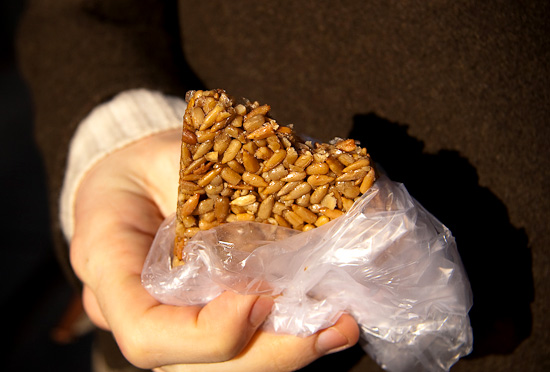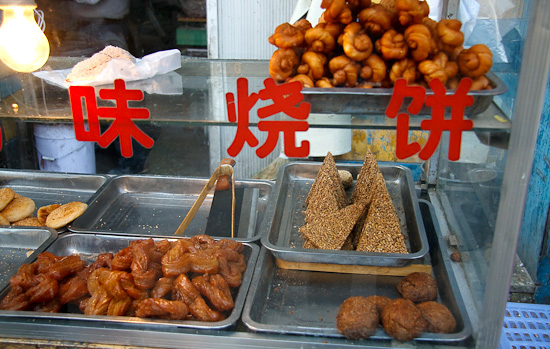
These are one of my favorite snacks when wandering around the hutongs of Beijing. They are almost granola bar-like, and seem to contain nothing more than what you can see and taste: sunflower seeds, honey and a dash of salt. It’s crunchy and nutty, not too sweet, rather perfect for both you and your pet hamster.
I bought this guazi bing (瓜子饼) on Yingtao Xiejie (樱桃斜街), one of the slanted streets that run northeast from the art stores on the eastern side of Liulichang. The vendor told me he made it by coating sunflower seeds in warmed honey, and then letting it set.
For RMB 3, you get a rather lot of sunflower seeds, densely packed (but it’s not so heavy that you can’t eat two at one go). They’re a delicious, inexpensive respite from the ubiquitous starch- or meat-based snacks like lamb kebabs and shaobing. They also seem to be rather healthful, as sunflower seeds are a good source of vitamin E, selenium and magnesium (though I can’t promise that no strange food additives were used!).
I first encountered guazi bing down in Guizhou province, where they were pre-packaged and sold by the side of the road. Since then, I’ve noticed them all around Beijing, where they are usually made fresh, no packaging.
Sunflower seed cakes are never enough to warrant dedication. Instead, these crunchy treats usually share real estate with shaobing, flatbreads (饼 bing), pastries, etc., in small food stalls or those glass-covered boxes that are wheeled around in tricycles. They can also be found in the sheds by the side of the road that sell jianbing, Beijing yogurt in a jug, popsicles, and beverages. But I’ve also, oddly enough, found guazi bing at a few newspaper and magazine vendors (书报亭 shubao ting).
In the photo above, the sunflower seed cakes are surrounded by mahua (麻花, top), tanghuoshao (糖火烧, directly in front), tang’erduo (糖耳朵, in front and to the left), and shaobing (烧饼, left). He also sells whole heads of candied garlic.




































